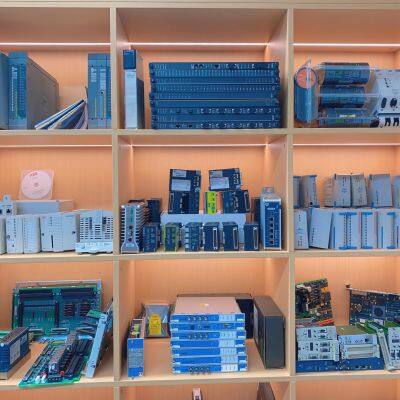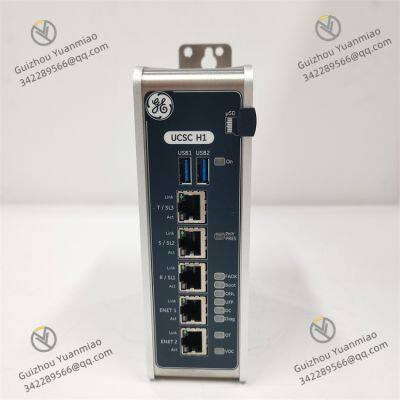Product Description
GE IS/IC/DS series modules
I. Overview
GE UCSC H1 IS420UCSCH1A-B is a high-performance industrial control module, specifically designed for integration with the Mark VIe series. It holds an important position in the field of industrial automation with its advanced functions and high reliability. It is equipped with a 1066MHz EP80579 Intel processor, which can efficiently process various complex data and control commands, providing strong power for the stable operation of industrial equipment. This controller supports TMR (Triple Modular Redundancy), simplex, and dual redundancy modes, which can meet the strict reliability requirements of different scenarios. Even in critical applications, it can effectively reduce the risk of downtime caused by faults and ensure production continuity. At the same time, it is highly compatible with IONet applications, enabling seamless integration into existing systems, which greatly improves the convenience of system integration and overall efficiency.

II. Technical Specifications
Processor Performance: It adopts a 1066MHz EP80579 Intel processor with strong computing power, which can quickly process large amounts of data and complex control tasks, ensuring timely system response and precise control. It is suitable for industrial control scenarios with extremely high real-time requirements, such as the control of high-speed production lines.
Input and Output Configuration: It is equipped with two Hall effect pulse inputs, two analog inputs, and four digital input/output (DIOS) ports. The Hall effect pulse inputs can accurately collect external pulse signals, which are used to measure parameters such as rotational speed and position; the analog inputs can receive signals from various analog sensors to monitor continuous variables such as temperature, pressure, and flow; the digital input/output ports can control the on-off status of external equipment to complete logical control functions, meeting the diverse signal acquisition and control needs of industrial sites.
Redundancy Support: It supports TMR, simplex, and dual redundancy modes. In TMR mode, three identical modules work in parallel to compare and verify data. When one of the modules fails, the system can automatically switch to the normal module to continue working, which greatly improves the system's fault tolerance; the dual redundancy mode uses two modules as backups for each other to ensure that the system can still run stably when one module fails, significantly enhancing system reliability. It is suitable for critical industrial processes that cannot be easily shut down, such as power production control in power stations.
Operating System: It runs the QNX Neutrino operating system, which has high reliability, real-time performance, and strong multitasking processing capabilities. In industrial environments, it can effectively handle complex control tasks and ensure stable system operation. Even under high-intensity workloads, it can ensure that all tasks are executed in an orderly manner without Laggy or delay, providing a solid software foundation for industrial automation control.
Communication Interfaces: It has rich communication interfaces, including Ethernet (dual-port redundancy), serial ports, Profinet, Modbus TCP/IP, etc. The Ethernet dual-port redundancy design ensures the reliability of network communication. When a network failure occurs, it can automatically switch links to maintain data transmission; the serial port can connect various devices with serial communication functions to achieve data interaction; the Profinet and Modbus TCP/IP protocol interfaces facilitate communication with industrial equipment and systems of different brands and types, enabling system integration and data sharing, and facilitating the construction of large-scale industrial automation networks.
Storage Capacity: The built-in storage is used for program and data storage, which can store a large amount of control programs, historical data, and equipment operating parameters. It ensures that key data is not lost when the system is powered off or restarted, facilitating subsequent analysis and tracing of equipment operating conditions, and also providing data support for the stable operation of the system.
Safety Level: It has obtained SIL3 certification, indicating that its reliability and safety in safety-related systems have reached a high level. Strict safety standards are followed in the design and manufacturing process, and multiple safety protection measures are adopted, such as hardware redundancy, fault detection and diagnosis, etc., which can effectively reduce the probability of dangerous faults in the system during operation, ensure the safety of personnel and equipment, and is suitable for industries with extremely strict safety requirements such as petrochemical and nuclear power.
Environmental Adaptability: It is suitable for harsh environments such as high temperature, high humidity, and industrial vibration. In terms of hardware design, special protective materials and processes are used to enhance the module's resistance to environmental interference; in circuit design, optimization is carried out to improve its resistance to interference such as electrical noise and voltage fluctuations, ensuring stable operation in complex industrial environments, such as steel plants, cement plants, and other harsh production sites.

III. Functional Characteristics
Data Acquisition and Processing: With rich input interfaces, it can collect analog and digital signals from various sensors in real-time, such as temperature sensors, pressure sensors, position sensors, etc. Through the high-performance processor, the collected data is quickly analyzed, calculated, and processed to extract valuable information, providing an accurate basis for subsequent control decisions. For example, in the chemical production process, real-time collection of parameters such as temperature and pressure in the reaction kettle, and adjustment of production process parameters after processing to ensure the safe and efficient progress of the production process.
Process Control: It supports multiple control strategies such as multi-loop control, sequence control, batch control, and optimization control. In multi-loop control, it can accurately adjust multiple control loops at the same time to maintain the stable operation of the system; sequence control executes each control step in sequence according to the preset logical order to realize the automatic operation of equipment; batch control is suitable for batch production processes, and uniformly manages and controls each batch of production; optimization control can automatically adjust control parameters according to real-time collected data and preset optimization goals to make the production process reach the best operating state, improve production efficiency and product quality, and is widely used in various links of industrial production.
Communication Function: Through multiple communication interfaces and protocols, it realizes seamless communication with other equipment and systems. It communicates with the upper computer, uploads the collected data to the monitoring center, facilitating operators to understand the equipment operation status in real-time; communicates with the I/O module of the lower computer to realize remote control of on-site equipment; and can also communicate with other intelligent equipment, such as intelligent instruments and frequency converters, to realize data sharing and collaborative work, and build a complete industrial automation control system.
High Reliability: Redundancy design and fault detection mechanism are important guarantees for its reliability. In addition to supporting multiple redundancy modes, it also has real-time fault detection function, which can monitor the operation status of hardware and software in real-time. Once a fault is detected, it can quickly issue an alarm and take corresponding fault-tolerant measures, such as switching to a backup module and adjusting the control strategy, to ensure uninterrupted operation of the system and reduce production losses caused by faults.
Flexible Scalability: By expanding the GE Mark VIe I/O module, the number and types of input and output points can be flexibly increased according to actual application needs, meeting the needs of industrial control projects of different scales and complexities. Whether it is a small automated production line or a large industrial production device, it can achieve precise control of more equipment and process parameters through reasonable expansion.

IV. Application Fields
Energy and Power Industry: In gas turbine and steam turbine control systems, UCSC H1 IS420UCSCH1A-B plays a core control role. It monitors the operating parameters of the turbine in real-time, such as rotational speed, temperature, pressure, etc., and accurately controls the fuel supply and steam flow of the turbine according to these parameters to ensure efficient and stable operation of the turbine, improve power generation efficiency, and ensure the reliability of power supply. At the same time, it is also widely used in substation automation and power grid dispatching automation of power systems to realize remote monitoring and control of power equipment and improve the intelligent management level of power systems.
Industrial Automation Field: It is suitable for the automation control of various industrial production lines, such as automobile manufacturing, electronic equipment manufacturing, food and beverage processing industries. Through precise control of various equipment on the production line, such as robots, CNC machine tools, conveyor belts, etc., it realizes the automation and intelligence of the production process, improves production efficiency, product quality, and reduces production costs. In the automobile manufacturing production line, it controls robots to complete the handling, welding, assembly of parts, etc., ensuring the accuracy and efficiency of the production process.
Petrochemical Industry: In the petrochemical production process, the safe and stable operation of production equipment is highly required. The controller can collect and process various process parameters in real-time, such as reaction temperature, pressure, flow, etc., and precisely control the production process to ensure that chemical reactions are carried out within a safe range. At the same time, it optimizes the production process and improves product yield. In addition, it can be integrated with the Safety Instrumented System (SIS) to quickly take safety measures in case of abnormal situations to ensure the safety of personnel and equipment.
Environmental Protection and Water Treatment Industry: In water treatment facilities such as sewage treatment plants and waterworks, it is used to control the operation of water pumps, valves, dosing equipment, etc. By monitoring water quality parameters and water level information, it automatically adjusts the operating status of equipment to realize the automatic control of the water treatment process, ensures that the treated water quality meets the standards, improves the efficiency of water resource utilization, and guarantees water supply safety.

V. Common Faults and Solutions
Communication Faults
Possible Causes: Damage to communication cables, such as cable aging, breakage, poor contact, etc., leading to signal transmission interruption; hardware faults of communication interfaces, such as damage to interface chips, loose solder joints, etc.; incorrect configuration of communication protocols, inconsistent communication protocols between different devices, making it impossible to correctly parse data; network interference, strong electromagnetic interference in industrial environments, affecting the quality of communication signals.
Solutions: Check the communication cables for obvious signs of damage, and replace the cables if any; for poor contact, re-plug the cable connectors to ensure a firm connection. If a hardware fault of the communication interface is suspected, use professional testing tools, such as oscilloscopes, logic analyzers, etc., to detect the interface circuit and replace the faulty components after identification. Carefully check the communication protocol configuration to ensure it is consistent with the communicating device, and reconfigure the protocol parameters if necessary. For network interference, the communication cables can be shielded by using shielded cables and reliably grounding the shield; install signal filters on the communication lines to reduce the impact of interference signals.
Abnormal Data Acquisition
Possible Causes: Sensor faults, such as sensor damage, aging, inaccurate calibration, etc., leading to abnormal output signals; faults in input interface circuits, such as damage to resistors, capacitors, leading to signal attenuation or distortion; packet loss, bit errors, etc., in data transmission, which may be caused by unstable communication links or electromagnetic interference.
Solutions: Calibrate or test the sensor using a standard signal source, and replace the sensor in time if it is damaged. Check the input interface circuit, and judge whether there are damaged components by measuring circuit parameters, such as resistance value, capacitance value, etc., and replace the corresponding components if any. For data transmission problems, check the communication link to ensure network stability, and redundant communication links can be used to improve reliability; at the same time, strengthen electromagnetic shielding to reduce the impact of interference on data transmission.
Controller Crash or Restart
Possible Causes: Hardware overheating, long-term high-load operation or poor heat dissipation, leading to excessive internal temperature of the controller, affecting the normal operation of the chip; software faults, such as program loopholes, memory overflow, etc., leading to abnormal system operation; power supply faults, unstable input power voltage, excessive ripple, or damage to the power module, affecting the normal power supply of the controller.
Solutions: Check the controller's heat dissipation system, clean the dust on the heat sink, ensure the cooling fan operates normally, and add external heat dissipation devices, such as cooling fans, heat sinks, etc., if necessary, to reduce the controller's temperature. Conduct a comprehensive inspection of the software, update to the latest version to fix possible program loopholes; optimize the program code to avoid problems such as memory overflow. Check the input power voltage, use a multimeter to measure whether the voltage is within the normal range, and install a voltage stabilizer if the voltage is unstable; replace the power module with the same specification if it is damaged.


Allen-Bradley 1756-A13 Seven (13) slot Chassis
Allen-Bradley 1756-CN2R ControlNet Communication Module
Allen-Bradley 1756-CN2RXT Controlnet Redundant Interface Module
Allen-Bradley 1756-CNB ControlNet Interface Module
Allen-Bradley 1756-DHRIO ControlLogix DH Plus/RIO Comms Module
Allen-Bradley 1756-DNB DeviceNet Scanner Module
Allen-Bradley 1756-EN2T Communication Module
Allen-Bradley 1756-EN2TXT EtherNet/IP-XT Module
Allen-Bradley 1756-ENBT Ethernet Bridge Module
Allen-Bradley 1756-EWEB Enhanced Web Server
Allen-Bradley 1756-IB32 Digital Dc Input Module
Allen-Bradley 1756-IC16 Discrete Input Module
Allen-Bradley 1756-IF4FXOF2F Analog I/O Module
Allen-Bradley 1756-IF6I ControlLogix Isolated Analog Input Module
Allen-Bradley 1756-IF8 Analog Input Module
Allen-Bradley 1756-IF16 ControlLogix Analog I/O Modules
Allen-Bradley 1756-IR6I Analog Input Module
Allen-Bradley 1756-IV32 Digital Input Module
Allen-Bradley 1756-L7SP Controller
Allen-Bradley 1756-L8SP Controller
Allen-Bradley 1756-L55 Processor Module
Allen-Bradley 1756-L63 ControlLogix Programmable Automation Controller (PAC)
Allen-Bradley 1756-L71 Programmable Automation Controller
High Precision Zygo 8010-0105-02 ZMI-501 Displacement Measurement Interferometer
 yezi
Hi there! Welcome to my shop. Let me know if you have any questions.
yezi
Hi there! Welcome to my shop. Let me know if you have any questions.







